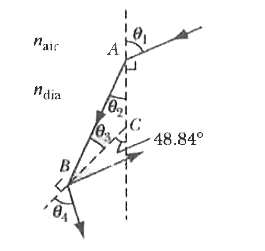Sparkle in the diamond
The purpose of a diamond is, of course, to sparkle . Part of the art of cutting a diamond is to ensure that all the light entering through the top face or side facets leaves through those surfaces, to participate in the sparkle. Figure 34-18 shows part of a cross-sectional slice through a brilliant-cut diamond, with a ray entering at point A on the top face. In this type of cut, the top and bottom surfaces have normal lines that intersect at the indicated 48.84∘. At point B, at least part of the light reflects and leaves the diamond properly , but part could refract and thus leak out of the diamond. Consider a light ray incident at angle θ1=40∘ at A. Does light leak at B if air (n4=1.00) lies next to the bottom surface ? Does light leak if greasy grime (n4=1.63) coats the surface? The index of refraction of diamond is nd∈=2.419.
Text Solution
When light reaches the interface between two materials with different indexes of refraction (call them n1 and n2 ), part of all of the light is reflected. The reflection is total if (1) the incident light is in the material with the higher index of refraction (n1>n2) and (2) the incident angle exceeds a critical value given by Eq. 34-10
θ=sin−1(n1n2)
If those two conditions are not met, part of the light is refracted across the interface according to Snell.s law.
Case 1 : Clean diamond
We need to follow the light from point A to point B to see if it can leak at point B. The light incident at point A is in the material (air n1=1.00) with a lower index of refraction than the material on the other side of the interface (diamond ndia=2.419). Thus, some of the light is refracted across the interface (the reflected portion is not shown in Fig. 34-18), and we find the angle of refraction from Snell.s law
Calculation :
θ2=sin−1(sin40∘2.419)=15.41∘
Now, note that the given angle of 48.84∘ at point C is an exteriror angle of triangle ABC and thus (from Appendix E), we can write
θ3+θ2=48.84∘
or θ3=49.84∘−θ2=33.43∘
This is the angle of incidence of the ray at point B. Now the incident light is in the material (diamond) with the greater index of refraction than the material (air) on the other side of the interface. However, if we apply Snell.s law at point B, we find no answer. The reason is that the light is incident at an angle greater than the critical value of
θcsin−1(n4ndia)=sin−1(1.002.419)=24.4∘
Thus, all the light reaching B reflects and none leaks out in the air.
Case 2 : Grimy diamond
We again follow the light from A to B, with the only difference lying in the last two calculations.
Now at B, the material on the other side of the interface is grime with an index n4=1.63. The incident light is again in the material with the greater index, but now the critical angle is
θc=sin−1(n4ndia)=sin−1(1.632.419)=42.4∘
Therefore, the incident angle n3=33.43∘ is less than the critical angle and light leaks through the bottom of the diamond.
From Snell.s law, the angle of refraction is
θ4=sin−1(2.4191.63sin33.43∘)=54.8∘
Learn Thus, to keep a diamond sparkling, clean both the top and bottom surfaces.

|
Updated on:21/07/2023
Topper's Solved these Questions
- BOOK - RESNICK AND HALLIDAYCHAPTER - GEOMETRICAL OPTICS : REFRACTIONEXERCISE - Check point6videos
GEOMETRICAL OPTICS : REFRACTION
- BOOK - RESNICK AND HALLIDAYCHAPTER - GEOMETRICAL OPTICS : REFRACTIONEXERCISE - Problems44videos
GEOMETRICAL OPTICS : REFRACTION
- BOOK - RESNICK AND HALLIDAYCHAPTER - GEOMETRICAL OPTICS : REFLECTION EXERCISE - PRACTICE QUESTIONS (Integer Type)3videos
GEOMETRICAL OPTICS : REFLECTION
- BOOK - RESNICK AND HALLIDAYCHAPTER - GRAVITATIONEXERCISE - PRACTICE QUESTIONS (INTEGER TYPE)4videos
GRAVITATION
Similar Questions
Knowledge Check
- Question 1 - Select One
Diamond is
Aan insulatorBa conductorCa semiconductorDnone of these - Question 2 - Select One
Diamond is a
Agood conductor and softBnon-conductor and softCnon-conductor and hardDgood conductor and hard - Question 3 - Select One
Diamond is a
Ametallic cyrstalBcovalent cyrstalCionic crystalDmolecular cyrstal

